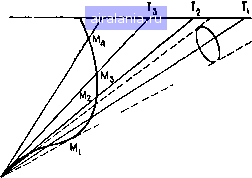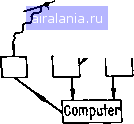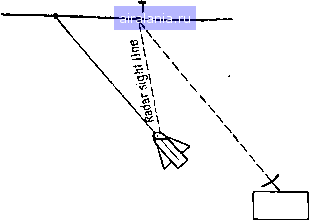

|
|
Главная -> Английский язык 0 1 2 3 4 5 6 7 8 9 10 11 12 13 14 15 16 17 18 19 20 21 22 23 24 25 26 27 28 29 30 31 32 33 34 35 36 37 [38] 39 40 41 42 43 44 45 46 47 48 49 50 51 52 53 54 55 56 57 58 59 60 61 62 63 64 65 66 67 68 69 70 71 72 73 74 75 76 77 78 79 80 81 82 83 84 85 86 87 88 89 90 91 92 93 94 95 96 97 98 99 100 101 102 103 104 105 106 107 108 109 110 111 112 113 114 115 116 117 118 119 120 121 122 123 124 125 126 127 128 129 130 131 132 133 134 135 136 137 138 139 140 141 142 143 144 145 146 147 148 Impad Тд  Successive target positions Beam shown when on position T, Radar successive positloni of the missile Fig. 1. Beam riding. П. Command Guidance. The traclting equipment follows the target as before. A second equipment continuously tracks the missile. A third equipment, a computer, works out at each instant the correct steering signals for the missile in order to head it towards the target successfully. A command link then sends the correct commands to the missile lo enable the control surfaces to be correctly operated. See Fig. 2. Target impact T path  \ Missile / \ Лгаскег / Command transmitter Target tracker Fig. 2. Command guidance. III. Homing Guidance. In this case target-tracking equipment is carried in the missile itself. For example, a miniature radar equipment carried in the missile continuously tracks the target, and, from this information a computer in the missile calculates the necessary signals so as to steer the missile to interception (Fig. 3). Impact  Homing head TracKing and Illuminating radar Fig, 3. Semi-active homing. There are three subdivisions: a. ACTIVE HOMING. In this case the missile itself radiates energy in order to light up the target in order to track it. b. SEMI-ACTIVE HOMING. In this case a tracking equipment on the ground illuminates the target continuously. c. PASSIVE HOMING. In this case the missile relies on energy radiated by the target itself, such as heat coming from the engines of an aircraft or a ship, or the targets own radio signals. IV. Inertia Navigation К The system is similar to the navigation of a ship by dead-reckoning*. In the latter case the navigator, knowing the latitude and longitude of his starting-point and that of his destination, computes the course that he must steer and the distance. Then, by using information about his actual course obtained from the ships compass and information about the distance gone, the navigator can mark off on his chart his calculated position without using any information from outside the ship. From this calculated position he can compute his new course to his destination. In a similar manner, a missile can be provided with an inertial navigation system which carried out a dead-reckoning calculation continuously in all three dimensions. * beam riding - наведение no лучу homing guidance - самонаведение inertia navigation - инерциальное наведение * dead-reckoning - счисление пути 3. SPACE POWER SYSTEMS (Для перевода со словарем) Many space ехр ment of e problems still remain to be solved before Interplanetary oration becomes a reality. One problem is the develop-ficient, low-weight electric power units to drive sub-systems of space vehicles. There are many types of indirect and direct conversion units for generation of electric power. Developments in fuel cells, solar cells and other space power sources are known as outstanding examples of astronautical progress. However, there are indications that real progress has only just begun. Recently it was noted that vastly greater amounts of electrical energy wi 1 be needed in manned space vehicles and this calls for design improvements which are now entirely out of reach. Future high-power solar cell systems probably will use concentrating devices to increase illumination on the solar-cell surface and decrease overall system weight and cost. A major breakthrough is required in achieving high-system efficiency before fuel-cell systems will be competitive with other thermal or direct conversion mechanisms. Space power systems are that particular branch of astronautics which relies on a number of different scientific and technological disciplines, each contributing to the other in an essential way. For instance, it has become increasingly clear that vastly improved high-temperature materials are essential before any breakthroughs can be achieved while improved design efficiences require weight reduction. Both problems fall in the domain of the solid-state physicist and the materials engineer. A related problem is that of heat rejection in space and how to take away unusable heat at low temperature in an air-free and gravity-free environment. Many people now take part in researth in these fields. Physicists, physical-chemists, so id-state technicians and engineering-physicists are likely to be attracted to these new activities in what is certainly one of the fas test-growing fields in the entire space business. КОНТРОЛЬНЫЕ ВОПРОСЫ 1. Как найти основное слово группы существительного (combustion chamber pressures in liquid rocket engines vary...; passenger-carrying airplane having...; the combustion chamber that...; the propulsion unit imaginable.,.) (§ 83)? 2. В какой последовательности следует переводить группу существительного с левыми определениями (§ 84)? 3. На какие вопросы могут отвечать при переводе слова, стоящие слева от основного слова (the gas-filled free balloon; passenger-carrying aircraft, fast-operating device)? 0 1 2 3 4 5 6 7 8 9 10 11 12 13 14 15 16 17 18 19 20 21 22 23 24 25 26 27 28 29 30 31 32 33 34 35 36 37 [38] 39 40 41 42 43 44 45 46 47 48 49 50 51 52 53 54 55 56 57 58 59 60 61 62 63 64 65 66 67 68 69 70 71 72 73 74 75 76 77 78 79 80 81 82 83 84 85 86 87 88 89 90 91 92 93 94 95 96 97 98 99 100 101 102 103 104 105 106 107 108 109 110 111 112 113 114 115 116 117 118 119 120 121 122 123 124 125 126 127 128 129 130 131 132 133 134 135 136 137 138 139 140 141 142 143 144 145 146 147 148 0.0094 |